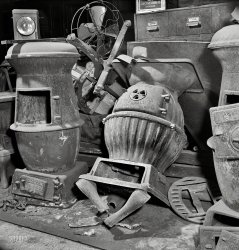
MAY CONTAIN NUTS

Search Shorpy
SHORPY ART

Framed or unframed, desk size to sofa size, printed by us in Arizona and Alabama since 2007. Explore now.
Join and Share
Ad-Free Shorpy
Shorpy is funded by you. Patreon contributors get an ad-free experience.
Learn more.

Recent comments
- From a buggy company came ...
- They call me Mister Horton
- Still Run
- Someone fed Jack some bad info.
- A Beautiful Machine
- It's official.
- Olive Brand Sportswear
- I still have a grudge against Texaco
- No GPS?
- CFG Bank Arena
- Van Lines
- Closed Station?
- John Vachon
- Folding Chairs
- TEXAGO
- Fragi-lay
- Classy
- Passenger seat
- No tipping
- The two front doors
- The theme song
- You are correct Dave.
- I was just there
- New to me
- Football-shaped thing
- Working all the live long day
- How do you stop slackers?
- It's [not] a Diamond T
- A Red Brown Truck
- Not Too Long a Long Walk
Member Photos
The Shorpy
Printporium
Printporium
Search Shorpy
Search results -- 30 results per page
- Off the Rails: 1862
- ... the Virginia Railway Express .
(The Gallery, Civil War, Geo. Barnard, Railroads) ... Posted by Dave - 07/21/2012 - 9:17pm -
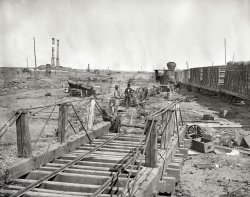
- Chicago: 1901
- ... 1901 That statue of the soldier is General Logan, the Civil War Officer who worked to have the 30th Day of May honor Military Dead as ... Posted by Dave - 07/20/2012 - 3:36pm -
![Chicago: 1901 Chicago circa 1901. "The lakefront from Illinois Central Station." Panorama of two 8x10 glass negatives. Detroit Publishing Company. View full size.
Would you really want to drinkthe "Best Kidney Water on Earth"?
StatueThat is one seriously gorgeous statue in the middle of the park.
Anyone have any info on that? Perhaps another photo?
[It's the Logan Monument.]
Thanks, Dave. Love the photos up close!
KodaksInteresting that one of the signs says "Kodaks Cameras and Supplies" and not "Kodak Cameras and Supplies."
[Shorpy abounds with signs advertising "Kodaks," meaning Kodak cameras. - Dave]
Illinois Central Station Are there any pictures of the Illinois Central Station available? I assume that this picture was taken from near the top of the clock tower looking north towards the lakefront.
[Also from the DPC:]
GrassDoes anyone know how they kept large expanses of grass like this mowed back in 1901?
[See this earlier comment.]
ObsolesenceIronic that CP Kimball's carriages and harness products would soon be obsolete with the advent of the automobile. Fast forward 110 years, and Kodak just announced they will file Chapter 11 bankruptcy due to digital photography making their own products obsolete.
Three agentsFrom the Ministry of Silly Walks, on the west side of the Michigan Avenue, lower left.
[Their apparent stance is an optical artifact.]
Holy landscaping!That area is filled with trees and concrete walks now!
Pollution?It's photos like this that leave me scratching my head whenever people start griping that our air isn't clean enough today.
KimballAn interesting piece on the Kimball family if you are so inclined.
http://www.coachbuilt.com/bui/k/kimball/kimball.htm
Kimball TimeOh my! It's K minutes to B o'clock! I better hurry or I'll miss my train.
Lakeshore DeltaIf you Google-Maps "901 S Michigan Ave, Chicago, Illinois 60605" you can see that all the Lake Michigan waterfront visible in this photograph was filled-in and is now occupied by the Buckingham Fountain, 6 tennis courts, 16 baseball diamonds, South Columbus Drive, and even South Lakeshore Drive.
Henry GeorgeFascinating to find a 5-cent cigar named after Henry George (1839-97), founder of "Georgism" and author of "Progress and Poverty." He proposed the "single tax"--based on the theory that land, and thus rents, should be common property. Given that, shouldn't tobacco products be free?
All Gone, Up to a PointEvery building shown here lining the west side of South Michigan Avenue has been demolished and replaced with bigger and usually better buildings - up to the point just beyond the "Studebaker Bros." sign. Then we see three great buildings in a row, all still standing: 1) the first portion of the Congress Hotel (originally the Auditorium Annex, Clinton J. Warren, 1892-1893), 2) the Auditorium Building (Adler & Sullivan, 1887-1889), and 3) the Fine Arts Building (formerly the Studebaker Building, Solon S. Beman, 1884-1885). The slender tower in the distance belongs to the Montgomery Ward Building (Schmidt, Garden & Martin, 1897-1899); it, too, is still standing, but its steep sloping roof was lopped off long ago.
Chicago: 1901That statue of the soldier is General Logan, the Civil War Officer who worked to have the 30th Day of May honor Military Dead as "Decoration Day" / "Memorial Day".
General LoganWas a focal point of the 1968 demonstrations during the Democratic Convention.
Montgomery Ward BuildingAs Michael R says regarding the Montgomery Ward building, "the steep sloping roof was lopped off long ago." Here is a photo showing what is the top of the building today.
Current ViewI was fortunate to live in building on site of old Illinois Central Station and have this view of same locale looking north during my two years in Chicago.
(Panoramas, Chicago, DPC, Railroads)](https://www.shorpy.com/files/images/SHORPY_Chicago_Panorama.thumbnail.jpg)
- Occupied Atlanta: 1864
- ... Hall in background." From a series of photographs, "War in the West," made by George N. Barnard. Wet-plate glass negative. View ... House when traveling east.
(The Gallery, Atlanta, Civil War, Geo. Barnard, Railroads) ... Posted by Dave - 07/22/2012 - 2:45pm -
![Occupied Atlanta: 1864 1864. Atlanta, Georgia. "Atlanta railroad depot and yard; Trout House and Masonic Hall in background." From a series of photographs, "War in the West," made by George N. Barnard. Wet-plate glass negative. View full size.
"Sherman in Atlanta, September-November 1864. After three and a half months of incessant maneuvering and much hard fighting, General Sherman forced Hood to abandon the munitions center of the Confederacy. Sherman remained there, resting his war-worn men and accumulating supplies, for nearly two and a half months. During the occupation, George N. Barnard, official photographer of the Chief Engineer's Office, made the best documentary record of the war in the West; but much of what he photographed was destroyed in the fire that spread from the military facilities blown up at Sherman's departure on November 15."
GWTWThis photo was obviously taken before Sherman destroyed Atlanta as his troops were leaving town. This photo of the open space in the yards might have been used as the inspiration for the panoramic scene in "Gone With the Wind" showing the multitudes of the dead and dying Confederate troops, no?
[This picture was taken after the Great Fire of September 2, which marked Sherman's arrival in the city. - Dave]
View from the skyHere is a bit of a painting of "Atlanta in 1864" by Wilbur G. Kurtz as reproduced in "Yesterday's Atlanta" by Franklin M. Garrett. Your photo appears to be taken from the City Hall (?) building in the top left. The Trout House can clearly be seen in your photo beyond the station and what the legend of the painting calls the City Park. It also says that the building with the sloping roof to the right of the Trout House is the Masonic Hall.
The photo and painting don't quite match. The photo shows clear ground in the foreground while the painting shows houses. At the right the photo also shows what appears to be a circular building (locomotive roundhouse?). This can also be seen right at the end of the street in a previous post.
This was taken from the right of the painting image looking left with the large Franklin Printing House building clearly visible on the right hand side of the street. The legend of the painting mentions a roundhouse, but doesn't actually seem to show it.
What's there now? I dread to think.
The Great Fire of Sept. 2, 1864This is an excerpt from "Atlanta and Environs," Vol. 1, by native Atlanta historian Franklin Garrett. More here.
By midnight of September 1st most of the troops had left the city. But a few cavalrymen lingered. They had a special assignment. Hood had no idea of leaving behind, in usable condition, ammunition and military stores for the use of his adversary.
Shortly after midnight the citizens who had remained in the city were startled by a series of violent explosions from down the Georgia Railroad opposite Oakland Cemetery and the rolling mill.
Hood's ammunition trains, consisting of seven locomotives and 81 loaded cars, had been set afire to deny them to the Federals. As the flames reached each car, it exploded with a terrific din. Five hours were occupied in this work of demolition, which also included the rolling mill. Flames shot to a tremendous height and the exploding missiles scattered their red-hot fragments right and left. The earth trembled. Nearby houses rocked like cradles, while on every hand was heard the shattering of window glass and the fall of plastering and loose bricks. Hundreds of people flocked to high places and watched with breathless excitement the volcanic scene on the Georgia Railroad.
Fortunately all the citizens in the vicinity of the explosions had been ordered to leave their houses before the work of blowing up the ammunition trains commenced. Every building, for a quarter of a mile around was either torn to pieces or perforated with hundreds of holes by shell fragments. A new day was dawning when the last car let loose, and the last Confederate cavalrymen galloped out McDonough Road (Capitol Avenue) to rejoin Hood's retreating army.
Blow-UpIs it possible to enlarge the sign on the rear of the wagon in the center of the photo? Appears to be in sharp focus, but can't quite make out what it says, might be something interesting!
HotlantaRemember there were two fires in Atlanta -
The Great Fire of Sept 2 - this is the fire in GWTW and was caused when Hood burned up his ammunition trains -
The second fire was when Sherman left to March to the Sea on Nov 15 and the Union Army burned 'anything of value' to the Confederates and, well, things got out of hand -
From Sherman's Memoirs - About 7 a.m. of November 16th we rode out of Atlanta by the Decatur road, filled by the marching troops and wagons of the Fourteenth Corps; and reaching the hill, just outside of the old rebel works, we naturally paused to look back upon the scenes of our past battles. We stood upon the very ground whereon was fought the bloody battle of July 22d, and could see the copse of wood where McPherson fell. Behind us lay Atlanta, smouldering and in ruins, the black smoke rising high in air, and hanging like a pall over the ruined city. Away off in the distance, on the McDonough road, was the rear of Howard's column, the gun-barrels glistening in the sun, the white-topped wagons stretching away to the south; and right before us the Fourteenth Corps, marching steadily and rapidly, with a cheery look and swinging pace, that made light of the thousand miles that lay between us and Richmond. Some band, by accident, struck up the anthem of "John Brown's soul goes marching on;" the men caught up the strain, and never before or since have I heard the chorus of "Glory, glory, hallelujah!" done with more spirit, or in better harmony of time and place.
That ConcertI am currently doing a lot of research on the history of theater in Atlanta. One of my sources states that Sherman attended 17 band concerts in the old Atheneum (noted in the photo) during the Federal occupation. Since the last info appears to be the date of Nov. 8, it seems to be a rough advertisement for one of those concerts. The Atheneum was on the north side of Decatur Street just before the Trout House when traveling east.
(The Gallery, Atlanta, Civil War, Geo. Barnard, Railroads)](https://www.shorpy.com/files/images/03475a.thumbnail.jpg)
- Bridge Out: 1865
- ... in Richmond in '65.
(The Gallery, Boats & Bridges, Civil War, Railroads, Richmond) ... Posted by Dave - 07/31/2013 - 1:24pm -
![Bridge Out: 1865 April 1865. "Richmond, Va. Ruins of Richmond & Petersburg Railroad bridge." Span over the James River, burned by Confederate troops before the advancing Federal Army. Wet plate negative by Alexander Gardner. View full size.
Remains of the supports left of route 60.View Larger Map
The Rail Linehere is the Richmond & Petersburg. The brick structure the left is presumably the burned-out paper mill; to the right and behind the photographer was the railroad depot. This is less than a half-mile from the (then and now) State Capitol, but a bit farther because of the need to find a bridge across the James River and Kanawha Canal, that passed between.
Well builtWell built, main arterial bridge support, I'm surprised it was never rebuilt for rail use.
The Great ConflagrationLooking at this one gets an idea of the mayhem and terror of a city in its death throes. Put this image with the many others taken of the industrial district and put them alongside those of Berlin or Dresden in 1945 and you can barely tell them apart. Although the occupation of Richmond was nowhere near as bad as was expected, the night the Confederate Army abandoned it held as much confusion and fear as any city in history left to hordes of invaders. Besides the columns of troops marching out, the streets were filled with half starved women and children looting government storehouses, unemployed prostitutes (at least temporarily), street urchins, deserters and gangs of released prisoners from the penitentiary stealing from everybody and drinking from the street gutters the whiskey poured out by the provost guards. During all this, munitions dumps were exploding and raining shrapnel all over the place. Several accounts from soldiers leaving the city recall the sight of the burning city and one described it as being "at once, both terrible and sublime". Another compared it to Dante's Inferno. By the grace of God, the yankee "hordes" were not as bad as feared and order was quickly brought to the city. But we have to remember that on that night, the citizens and soldiers (many of whom left loved ones behind) didn't know that. They didn't know that a day later Lincoln would tell the general commanding the occupying troops to "...let them up easy, General, let them up easy."
A Couple near the riverDid anyone else notice the couple sitting near the river (approximately 25 feet or so) to the left of the burned out bridge?
[Looks like three people. -tterrace.]
Re: A Couple Near the RiverIt's very possible that they are paroled Confederate soldiers wondering how to get across so they can go home. Or they could be displaced workers from one of the mills or the Armory. There were a lot of people and soldiers from other parts of the state and other states as well as foreigners cast adrift in Richmond in '65.
(The Gallery, Boats & Bridges, Civil War, Railroads, Richmond)](https://www.shorpy.com/files/images/SHORPY_02892a_0.thumbnail.jpg)
- Ghost Coach: 1930
- ... train crash -- at Quintinshill during the first World War -- I believe more died in the fire afterward than in the impact.
4928 ... other cars would be removed first.
In the American Civil War, cars from other railroads were often borrowed to move troops. This ... Posted by Dave - 07/22/2012 - 7:02pm -
![Ghost Coach: 1930 Washington, D.C., or vicinity circa 1915-1930. One of three H&E glass negatives labeled "Car exterior. Washington & Old Dominion R.R." Harris & Ewing Collection glass negative. View full size. The others are here and here.
Mail CarThat was a mail car, usually the first car behind the tender car.
All Aboard for Petticoat Junction!But where's the rest of the Hooterville Cannonball?
Combination CoachThis old gal carried passengers as well as mail and parcels between cities. One great picture and she was probably on her way to the scrap yard.
Good EngineeringThis is obviously an OLD car by 1930, built maybe at the turn of the century, yet look at its excellent construction. 6-wheel bogies with elaborate suspension for a smooth ride, the long chassis still straight as an arrow despite its age, lots of elbow room inside with elegant clerestory windows and lots of ventilators. This was the product of a thriving American transportation industry at the top of its game.
Pretty butOld coaches are the same this side of the water; lovely to look at and deadly dangerous if there's a crash. There's breakable, splintering, flammable wood, gas lighting in some cases, paraffin or kerosene in others. In Britain's worst train crash -- at Quintinshill during the first World War -- I believe more died in the fire afterward than in the impact.
4928Perhaps this was a mail car or a car with space for freight, but there is also obvious passenger seating in it as well. And if it typically traveled just behind a tender, why would it have that "porch" on its freight end?
Cue the Ghostly OrchestraClang, Clang, Clang went the Scary Trolley!
Ding, Ding, Ding went the Bell of Death!
Zing, Zing, Zing went my heartstrings as we started for Spookington Dell!
And this car isA 1908 PRR roster shows this as a Class OK combine (baggage/coach) built in 1900 and owned by the PB&W (the subsidiary of the Pennsy that owned the tracks on the line from Philly to DC). These cars were rebuilt with full vestibules at some point, because there is a diagram for that configuration; obviously this one escaped. Apparently these cars always had steam heat. There were three different subclasses depending on the size of the baggage compartment; this is the smallest, with the 20-foot compartment.
The six-wheel trucks show that this is a "heavyweight" steel car. The interior appears to have walkover seats so the car doesn't have to be turned. Platforms (and later vestibules) were typical on baggage cars to allow train crews to pass through while in motion.
The Ghost CarI agree with the first description of this car's origins. The car was still on the PRR roster on 1-1-1914, but was gone by 3-1-1916. The lettering couldn't have lasted 14 years. My guess is the photos were taken shortly after sale to the W&OD. Moreover, the truss rods under the center of the car indicate that this was a fully wooden car both when it was constructed and when these photos were taken.
Further ResearchI've come across a classification guide which indicates that class O cars are wooden combines. Class PB steel combines in the same guide are only about 10 feet longer, but weigh 50 percent more (120,000 vs. 80,000 pounds).
Checking in Ames's book on the W&OD, I see absolutely no evidence that this car was ever used on that line. Passenger operations were electric, with the exception of several 1878/1887 coaches purchased from the Manhattan Electric Rwy which were considerably older in design than this car. The only combines on the roster were either electrics or doodlebugs. My guess is that this car was just passing through.
[I think there was probably another reason for taking these photos. - Dave]
PilotThis car seems to have a tube pilot on the far truck, which might indicate it was used behind an interurban or box motor in push/pull service.
Thoughts on the Mystery CoachChecking Herb Harwood Jr.'s "Rails to the Blue Ridge: The Washington and Old Dominion Railroad, 1847-1968" I find no reference to any ex-Pennsylvania railroad coaches in the company's roster. That being said, I have a couple of ideas.
As far as the location of the photograph, the coach appears to be sitting on one leg of a wye, used for turning locomotives or whole trains (given the length of the stub track, just locomotives in this case). According to Hardwood's track map, and assuming this is the Washington & Old Dominion Railroad, that leaves four possible locations for this photograph: Bluemont Junction, Herndon, Leesburg, or Bluemont. Given the topography in the background, and having bicycled the W&OD quite a lot, I would suggest the likely location of this to be Bluemont Junction.
I have come up with one possible explanation for why this coach never appeared on the company rosters. It is possible that this coach was purchased by the Washington & Old Dominion Railroad, but never operated over the line, and simply sat disused in its location pictured. The three-axle trucks indicate to me that the coach is possibly quite heavy, perhaps too heavy to operate on the W&OD's light rails. It certainly would not have been the only instance of a railroad purchasing equipment too heavy for its rails. (In my home province of Ontario, one of the two locomotives of the Huntsville and Lake of Bays Railway was found to be too heavy and remained stored during its 11-year career on the railroad).
One other possibility that has come to mind is that this is not the Washington & Old Dominion Railroad at all, but rather the Rosslyn Connecting Railroad which branched off the current rail line as it reached the Virginia side of the Potomac, and headed north to Rosslyn. This railroad was a subsidiary of the Pennsylvania Railroad, which would explain the coach. If the photograph was simply labeled (Washington DC area), it is possible that the railroad was misidentified. This, however, is complete conjecture, as I am not even sure whether passenger service was ever operated (or intended to be operated but wasn't) over the Rosslyn Connecting Railroad.
[The photos are labeled as indicated in the caption. - Dave]
One thing I can say for surethe number designations on the car are most definitely
"Pennsy".
That font is unmistakable.
#4928 Pennsylvania Combination carMy opinions are just that--pity the photographer isn't alive to comment. That said:
I disagree with the car going to scrap. The gas light globes are still inside the interior. If it is to be scrapped all the parts to keep for repairing/building other cars would be removed first.
In the American Civil War, cars from other railroads were often borrowed to move troops. This inter-rail cooperation worked well-- There are several military grounds near the W&OD RR. Fort Myer, Va. and Camp Auger, near Merrifield, Virginia - off the Dunn Loring RR stop on the W&OD line. Livestock pens were near the one W&OD RR's freight station for the Cavalry horses and or livestock being shipped to and from the more western towns, e.g. Herndon, etc.
Military grounds near railroad lines would be Camp A. A.Humphreys aka Fort Belvoir, Virginia; Quantico, Virginia which are off the Alexandria Railyard heading south on the Southern, Richmond, Fredericksburg & Potomac line. On the Mt. Vernon line, it could have gone by Fort Marcy.
It could have easily been sold to Virginia Central Rwy or the Fruit Grower's Express Rwy, for the use of the company's executives or for an occasional run for passengers; e.g. executive use, party, etc.
It may be entirely possible that this car never went past the railroad bridge into Virginia. It could have easily been sold to a short line (East Washington, Rwy)and or sitting in the more rural sections of Washington, DC around Ivy City--a connecting yard to Union Station.
If memory serves me correctly, Penn RR did invest in the W&OD briefly. This may be of that brief period.
A combine, but not for mailThese three pictures show a rail car that once ruled the main line but now has been modified for a lowly afterlife on a forgotten branchline. The car has a 20-foot compartment for freight and express at one end. The pigeonhole box near the roof line being for small packages and company mail moving from station to station. If it were a US Mail compartment, there would have been the mandatory fixtures for bags, pouches, sorting tables and sorting racks - plus there would have been a letter drop slot on the side of the car. The rear section offers walk-over coach seats.
We can see this was a mainline car account of the six wheeled trucks, walkway buffers and the three hoses next to the coupler. One hose was for airbrakes, one was a communication line to signal to the engineer by the train crew, and one was for steam heat. The pilot (or cowcatcher to some) on the far end of the car implies some type of push-pull service.
If this the W&OD, I believe they had some self-powered "doodlebug" cars and this car could have served as a trailer being pulled along by the power car, until it was time to return and the train was shoved back towards its origin. A procedure quite effective to give the engineer a cramped neck, and the flagman the worry of being on the cutting edge of any grade crossing incident with a car or truck. The flagman usually manned a little peanut whistle powered by the air line that he would signal with as the train approached crossings and stations.
The carHere is a link that refers to this car.
(The Gallery, D.C., Harris + Ewing, Railroads)](https://www.shorpy.com/files/images/20626a.thumbnail.jpg)
- Detroit River: 1900
- ... Dali's "Soft Construction with Baked Beans (Premonition of Civil War)"?
Wow This photo is incredible.
Very alive This ... Posted by Dave - 08/02/2012 - 3:18pm -
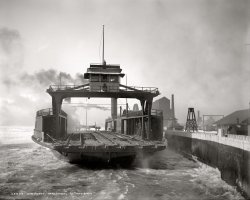
- The R.R. Arch: 1908
- ...
One armed man You may be looking at a veteran of the Civil War.
Switch Points The man with the cane just might be working for the ... Posted by Dave - 02/03/2013 - 4:59pm -
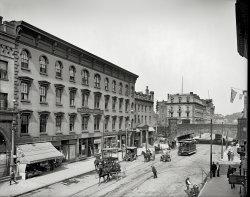
- Cotton on the Levee: 1903
- ... de Armes in Spanish times).
A Short 38 Years The Civil war had ended only 38 years before. Some of the people in this picture were ... Posted by Dave - 08/09/2012 - 2:43pm -
![Cotton on the Levee: 1903 New Orleans circa 1903. "Mule teams and the levee." 8x10 inch dry plate glass negative, Detroit Publishing Company. View full size.
Behemoth ShipSecond time this ship has shown up on Shorpy and I still can't place her. She is a massive ship for her time, and much different from the Great Lakes freighters we see here frequently.
[It's the SS Proteus. - Dave]
CapturedA "Porgy and Bess" moment; you get the feeling that any moment great music will erupt. Or not.
Jax BreweryThat looks like the Jax (Jackson) Brewery behind the IC freight car. If so, we are facing upriver. The Jax brewery was converted to shops and restaurants many years ago. It's situated on Decatur street across from Jackson square (Plaza de Armes in Spanish times).
A Short 38 YearsThe Civil war had ended only 38 years before. Some of the people in this picture were probably born into slavery.
FlotsamI'd love to know the story about the stuff floating in the water at the left edge.
SS ProteusThinking of that ship got me poking around to read of it's sinking; found here
http://www.divehatteras.com/proteus.html
The train that traveled northThe Illinois Central train traveled from New Orleans all the way north to Chicago. This is the route all blues artists and African Americans took to leave the south in droves to better lives up north,where there were jobs in countless factories,and better pay than picking cotton.
Jackson BreweryYes, that is indeed the Jackson Brewery, and we are looking uptown toward Canal St. As someone commented on the other picture like this, you can also see St. Patrick's Church steeple off in the distance to the right.
(The Gallery, DPC, Horses, New Orleans, Railroads)](https://www.shorpy.com/files/images/SHORPY_4a17029a.thumbnail.jpg)
- Commuters: 1907
- ... in this country and only 42 years past the darkness of the civil war!
Security I got a kick out of seeing what I think is the long arm ... Posted by Dave - 07/30/2012 - 10:07pm -
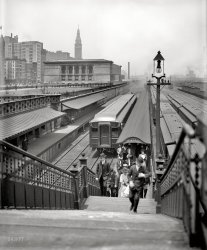
- Timeless Depot: 1906
- ... Jesse Green (1801-1846) and Martha Ann Wright. During the Civil War he was in the 13th Virginia Light Artillery Company C which fought the ... Posted by Dave - 10/29/2014 - 5:06pm -
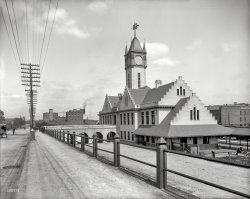
- Detroit Opera House: 1904
- ... was formed in May 1906 by Ohio native Henry M. Wright (a Civil War veteran as a member of Co. B, 85th Ohio Volunteers) and John Kay, who was ... Posted by Dave - 07/19/2012 - 10:23pm -
![Detroit Opera House: 1904 The Detroit Opera House circa 1904, starring an electric runabout out front. 8x10 inch dry plate glass negative, Detroit Publishing Company. View full size.
Detroit Conservatory MusicWhat, they were too cheap to spring for an "of"?
Digital sign againI've noticed that each time we've seen one of those "digital" signs it's been on or in front of a large theater, opera house or concert hall, the type of venue you'd expect the upper classes, rather than the hoi-polloi, to frequent. My speculation: it's something used to signal carriages for their ritzy patrons. Below: this one compared to ones at Philadelphia's Nixon Theatre and Academy of Music.
Update: Thanks to TomHe for confirming my speculation.
High Bridge?Look in the window of the Pennsylvania Lines shop. Is the picture on the easel that of the High Bridge of recent memory?
[Unfortunately, no. - tterrace]
Videochas PicThat's Horseshoe Curve, near Altoona, PA
Makes My Heart SingWhat a lovely building! I was born in the wrong era. I come to Shorpy everyday and I'm never disappointed with the photos here. I would hope this building is still standing. I absolutely love the honeycomb glass transom at the entrance door. I wish buildings of today had the details of old world craftsmanship. Sigh.
[Demolished 1966. - tterrace]
What is that thang?Sharp eyes as usual from tterrace, but I can't make out just how this configuration of three identical sets of light-bulb "dots" could be lit to form letters or numbers. The mysterious device's Academy of Music installation, at right, appears to include some kind of identifying signage on the end of the clapboard base beneath it. Dave, is your highest-res tiff file of this photo sufficiently clear to read that information?
[Not clear enough on the full LOC tiff, unfortunately. - tterrace]
Pennsylvania LinesThe Pennsylvania Railroad was a late arrival in Detroit, not gaining a direct entrance there until 1922, and then only by trackage rights on the Ann Arbor, Pere Marquette and Wabash Railroads. The Grand Rapids and Indiana Railroad was chartered in 1854 to build a line from Fort Wayne to the Straits of Mackinaw through Grand Rapids. It became part of the Pennsylvania Lines in 1869. It too had no direct connection to Detroit, relying on a connection with the Wabash in Ft. Wayne to get to the Motor City.
Identify car?Great picture! Can anyone identify that nifty little car?
The proverbial needleConcerning identifying the automobile, unless it was built by a select few makers, I doubt it can be positively identified.
During this period there were around a thousand automobile manufacturers in America alone. What we do know is that it's an early brass era runabout with tiller steering, semi-eliptical leaf springs at each corner, and wooden spoked wheels. That should narrow it down to about 50 manufacturers, some of which existed for only a few years.
Re: The proverbial needleI think I have identified the car. It's an AJAX ELECTRIC. I have attached a photo from an advertisement from 1903, for visual comparison.
[Here they are together. Among other differences, note the absence of front leaf springs. - tterrace]
Wright & KayThe jewelry firm of Wright & Kay (big sign atop building) was formed in May 1906 by Ohio native Henry M. Wright (a Civil War veteran as a member of Co. B, 85th Ohio Volunteers) and John Kay, who was born in Scotland. They were jewelers, opticians, importers and dealers in watches, clocks, diamonds, marble statuary, silver and plated ware and fine stationery, and they manufactured watches and other products under their own name. Recently some Wright, Kay & Company watches were auctioned at Christie's.
About that haystackMy first thought when I looked at the full-size image was Studebaker. After further research the answer will have to be no, they were building a Runabout with very similar bodywork and proportions in that era but it had major mechanical differences from this machine.
As BradL said, this was a time when literally hundreds of companies ranging from blacksmiths, to buggy shops, to established manufacturers of sewing machines and other mechanical equipment, all took a fling at the automobile.
MysterymobileI'm almost certain it's a Waverly Runabout, built in Indianapolis. I have a current-day photo but it's somebody's property. Note its steering is via a front tiller whereas the Studebaker has its tiller on the side.
Re: Digital sign againA carriage call indeed. Picture below shows numbers lit.
WaverleyDon Struke has it, I found a vintage Waverley advertisement that certainly seems to match the mystery car closely.
HorsesCalm and unaware that they were about to be unemployed in very short time.
(The Gallery, Cars, Trucks, Buses, Detroit Photos, DPC, Performing Arts)](https://www.shorpy.com/files/images/SHORPY_4a11547a.thumbnail.jpg)
- Eads Bridge: 1901
- ... Eads Mr Eads owned a shipyard at the time of the Civil War. He is well known for having built a fleet of war ships that patrolled the ... Posted by Dave - 05/22/2017 - 1:41pm -
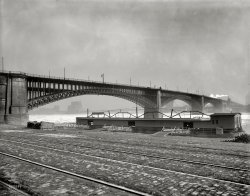
- Vicksburg Panorama: 1909
- ... how much of the construction along the waterfront is post-war. Vicksburg experienced quite a boom in population growth between 1860 and ... Falls City are buildings in disrepair, could they be civil war casualties?
[From 50 years earlier? That's fire damage. - Dave] ... Posted by Dave - 02/25/2014 - 11:33am -
![Vicksburg Panorama: 1909 The Mississippi River circa 1909. "Vicksburg waterfront." A panorama made from three 8x10 glass negatives (the widest image, pixel-wise, that Shorpy has ever posted -- be sure to scroll all the way over to the right). The nine-story skyscraper is the First National Bank. Detroit Publishing Company. View full size.
PanoramaI know of one panorama William Henry Jackson composed for Leadville, CO, although I don't know if it was while he worked for DPC. His "stitching" technique involved three large prints on easels, which he re-photographed. I found the process documented in a series of photos in the Denver Public Library.
Chinese groceryWhat a fascinating image. An unexpected surprise was the "Quong Yulin & Co." grocery, a few blocks away from "Sol. Fried" store.
Wikipedia currently lists Vicksburg at less than 1 percent Asian. Vicksburg's 165-year old Synagogue now has just 20 members.
I wonder how much of the construction along the waterfront is post-war. Vicksburg experienced quite a boom in population growth between 1860 and 1870.
Earlier components?I seem to recall parts of this (great) panorama as previous Shorpy photos. Can someone post links to them?
[One photo. Our Search box would take you here. Waiting in the wings, there is at least one other version of this scene taken the same day, for a total of three. - Dave]
Remarkable detailThis is a remarkable image. I wonder if Detroit Publishing produced any more of these stitched multi-image panoramas.
[Click the "Panoramas" link above the photo. The stitching is all done by me, and Photoshop. - Dave]
No Horseless CarriagesTypically photos of this vintage display horse & buggies AND early automobiles. Was Vicksburg behind the times or could it be the photo pre-dates 1909? Either way, this a facinating snapshot of a moment in time along the Mississippi River.
[The First National Bank building was completed in 1907. - Dave]
Seek and you shall findWay on the right, a Coca-Cola sign.
[Actually there are three. - Dave]
Very DirtyAn amazing photo. The thing I am thinking about is that all the ladies seem to be wearing long white dresses and the streets appear to be all dirt. Their clothing must have gotten filthy in a very short time from simply walking the streets. I am also loving the Steam Boat Exchange Saloon, I wonder what curious sights were beyond those doors ??
Merchants DespatchWell weathered.
Above the Falls Cityare buildings in disrepair, could they be civil war casualties?
[From 50 years earlier? That's fire damage. - Dave]
Coca-Cola and VicksburgVicksburg was home to the Biedenharn Candy Company, the first bottler of Coca-Cola. Although the drink was created in 1886, it was sold mainly at druggists and soda fountains. Biedenharn started bottling the drink in 1894.
Did the channel change?I notice from the satellite view that the channel fronting most of the city is now the Yazoo River, not that there is much of a waterfront left. Such a channel change is something that General U.S. Grant unsuccessfully tried to engineer in 1862-1863, but it looks like nature finally did what 19th Century military engineering could not, as nature always does.
Many of these buildings remainHaving lived in Vicksburg, I can tell you that while a number of the buildings shown along the Mississippi riverfront have been torn down and replaced, still, many of the buildings pictured in this panorama are still there, being re-purposed with new businesses and tenants through the years.
On Washington Street, the street the First National Bank building is on (still there, its main floor used still as a bank with professional offices on the other floors), many of these buildings still remain. You'll notice the many steeples and cupolas on the skyline.
Going from left to right, the first steeple is that of Christ Episcopal Church (still there); the two-storied brick building with the cupola right on the river (with train cars pictured in front) is the old L&N Railroad Depot, now a Visitor Center. Atop the hill, the building with columns on all sides and the cupola on top is the old Warren County Courthouse (built in the late 1850s), now the Old Courthouse Historical Museum. Right across the street from the Old Courthuse, you see the "steeple" of the City Jail. Past the First National Bank Building, going east up the hill is the tower of the Carroll Hotel (a picture of which was posted on Shorpy several years ago -- The Carroll was torn down sometime in the late '40s or early '50s).
The church that is pictured was St. Paul's Catholic, destroyed in the early 1950s when a tornado did a lot of damage as well as killing a number of people. A new church was built on the site in the 1950s. The squareish tower is the top of the Army Corps of Engineers headquarters, now used as the HQ of the Mississippi River Commission. The tall steeple at the left is Holy Trinity Episcopal Church. At the extreme left, the top two floors of the light-colored brick building (another skyscraper of five stories!) was a popular department store known as The Valley, which did business until sometime in the late 1970s or early '80s. The building has been converted into condos.
At this time, the downtown streets of Vicksburg were not dirt but were paved with brick. The streets going east, up the bluffs from the river were (and still are) paved with cobblestones in order that vehicles can get some traction going up and down. When I started driving as a teenager in the 1960s, I was told that if you could learn to drive on the hilly streets of Vicksburg -- in a car with a standard transmission -- you could drive anywhere!
Alice Used to be FrankThe sternwheel packet Alice B Miller, seen here to the right, was built in 1904 at Jefferson, Indiana, as the Frank B. Hayne. She became Alice in 1908 and met her demise by fire in Vicksburg in 1915. Source: University of Wisconsin LaCrosse, Murphy Library.
Superb, engrossing imageFascinating - rewards hours of scrutiny! Just wanted to say a sincere thank you for putting this one together and sharing it with us.
Depot at VicksburgThis view shows the Yazoo & Mississippi Valley Railroad (Y&MV) depot, not the L&N.
Great panos!Thanks for the link to the panoramas you've stitched. I now have to look forward to hours in the time machine.
(Panoramas, Boats & Bridges, DPC, Railroads, Vicksburg)](https://www.shorpy.com/files/images/SHORPY_Vicksburg_Panorama_4.thumbnail.jpg)
- Railroad Bank: 1903
- ... business proved to be the more profitable and survived the Civil War and the Depression before eventually being absorbed in a series of mergers ... Posted by Dave - 08/28/2021 - 3:25pm -
![Railroad Bank: 1903 Augusta, Georgia, 1903. "Georgia Railroad Bank, Seventh and Broad Streets." 8x10 inch dry plate glass negative, Detroit Photographic Company. View full size.
My hometownIn "downtown" Augusta, there was a bank on the corner of Seventh and Broad Street from the 1830s until 2015! In 1967, sadly a large (sky scraper) building was erected to replace the beautifully designed bank pictured above. In 2015, Wells Fargo closed its branch (which was housed in the "skyscraper" built in '67).
In 1916, Augusta had a horrible fire that burned much of the town. However, the bank pictured in 1903 survived. My great grandfather took several photographs of the aftermath of the fire and floods through the years. He was a pediatrician in Augusta. His doctor's office was in the Lamar building on Broad Street. The Lamar building still stands today. I wish we still had the old glass plate negatives from the photographs he took.
Long historyThe Georgia Railroad and Banking Company (it did both) was chartered way back in the 1830s, making it one of the earliest railroads in the US. Over time the banking side of the business proved to be the more profitable and survived the Civil War and the Depression before eventually being absorbed in a series of mergers beginning in 1986. Today the parent company is Wells Fargo. The railroad also has disappeared in the usual run of corporate mergers, with CSX now controlling what is left of their old lines.
Homeless bank person?Is that a pioneer homeless fellow between the columns at the corner? Must be one of the first! He has a hat, and bundles, but no shopping cart or tent.
Wonder what his story really is.
[Um, that's a nursemaid with two baby carriages. - Dave]
History of the Bank and Buildingshttps://www.georgiaencyclopedia.org/articles/business-economy/georgia-ra...
I'll Huff and I'll PuffBut it's gonna take more than a gust a wind to blow that august Augusta building down!
(The Gallery, DPC, Railroads)](https://www.shorpy.com/files/images/SHORPY-4a10903a.thumbnail.jpg)
- Cadillac: 1908
- ... Those are solid frame types that you saw mostly during the Civil War. Given the condition of the car, I'd bet that it's an old link and pin ... Posted by Dave - 08/14/2012 - 1:01pm -
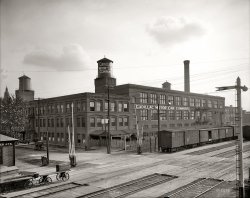
- High Bridge Depot: 1907
- ... suspension bridge. But that project got cancelled by the Civil War. (And that's probably a good thing, since I don't think suspension bridges ... Posted by Dave - 02/06/2012 - 4:14pm -
![High Bridge Depot: 1907 Circa 1907. "High Bridge station, High Bridge, Kentucky." 8x10 inch dry plate glass negative, Detroit Publishing Company. View full size.
The spur best not takenDon't think I want to be switched onto that spur to the left. I wonder if there was originally an incline to move materials up the mountain?
High on High BridgeOne of the barely remembered memories I have of University of Kentucky college life in the early 70s was walking out on High Bridge at night while, well, pretty darn high. Apparently, this was a popular stunt. Four or five of us thought this would be a good idea at the time. Until the train lights and whistle kicked in.
Thanks to Shorpy for getting me thinking of how a God knows how many car freight train blowing past you at night and close enough to reach out and touch feels like from the late winter of early 1973.
Mr. White HatJust had a brilliant idea.
Never Saw This BeforeIf you go to High Bridge, KY on Google Earth, there is a full three dimensional rendition of the present-day bridge. No station, though.
Signal smorgasbordA train crew would have to be alert to the various signals on display here. On the depot, above the bay window are the signals that alert the crew that train orders from the dispatcher need to be received. Across the tracks between the depot and turnout is a block signal that informs a train crew about what is ahead of them, or possibly informs them if they are to take siding here. And just to the right of the bridge is a Ball type of signal that may be part of the regular block signal system or one that assures the train crew that all is well on the bridge, or it is one that stops all trains if activated by a maintenance crew that would have work to perform on the bridge.
Why the NameBuilt to cross Stating the Obvious Creek.
Stay behind the yellow line!As an Amtrak agent for 23 years, I can say with certainty that standing as close to the track as possible while a train approaches is an obsession with the public. I've had several hundred people standing on a platform while a train was bearing down, all pressing each other as close to the tracks as they could. It scares employees to death, especially engineers. They would not be able to stop if someone fell off the curb, and then everybody would get to see how sausage is made. You just hope and pray that if it ever happens, it won't be a child.
The towersAs you might have guessed, originally this was planned to be a Roebling suspension bridge. But that project got cancelled by the Civil War. (And that's probably a good thing, since I don't think suspension bridges of that era were very good for railroads.)
[More here.]
High Bridge SignWhat are the two numbers on the sides of the High Bridge sign? One reads "CIN 100.3" and the other reads "CHA 234.8." Thanks.
[Distances to Cincinnati, Ohio and Chattanooga, Tennessee.]
Pedestrians Welcome?There's a gent who appears to be heading onto the span. If not a RR employee, I wonder if the bridge was open to pedestrians to cross. My gut tells me the RR wouldn't allow it, but the deck seems wider than need be, and could those be pedestrian hand ropes on the left edge?
Re: Pedestrians WelcomeIt wasn't unheard of for pedestrians to legally cross on railroad bridges. If there wasn't a nearby road or footbridge then the railroad would allow it. They'd often provide a walkway alongside the tracks for this purpose. In fact in some they still do. The CPR bridge here in Saskatoon has a pedestrian walkway that's used by university students to cross the South Saskatchewan River. It was designed for that purpose back in 1909.
Re: Signal smorgasbordThe white signal posing as Mr. Hat's brilliant idea is in fact a Hall or Banjo signal. Another can be seen on the other end of the bridge. Most likely this is part of a block signal system or possibly a block protecting only the bridge. The signal to the left appears to be part of an interlocking plant, rods for the switch and a point lock can be seen to the left. And of course the signal on the station is in fact a train order signal. The mishmash of train control here is great and typical of the time.
Two namesThis station has two names. When the agent communicates with the dispatcher or other stations using Morse or voice, his station name is "KR". KR would also be used on train orders, clearance cards, and anything else affecting train movements.
What's that short post with the number 103.2 on it? A mile post with a cross arm and insulators on it?
(The Gallery, Boats & Bridges, DPC, Railroads)](https://www.shorpy.com/files/images/SHORPY_4a13855a.thumbnail.jpg)
- Working Horses of Hoboken: 1910
- ... before the advent of modern lumbermills after the Civil War; ditto the large plate glass windows. I won't go too deeply into a ... Street."
(The Gallery, Boats & Bridges, DPC, Horses, Railroads) ... Posted by Dave - 08/15/2012 - 4:35pm -
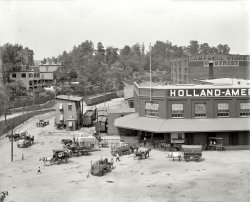
- Strangers on a Train: 1928
- ... to think the elderly gentleman on the left might be a Civil War vet--and the Navy man might serve in WWII.
Next stop.... Next stop, ... Posted by Dave - 09/04/2012 - 12:03pm -
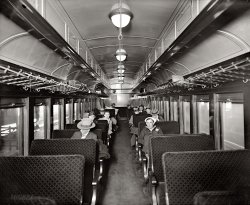
- Lemont Depot: 1902
- ... took them almost 100 years to start recovering from The War.
The track structure is showing signs of modern evolution. Six-hole ... joint between rails. In earlier Shorpy photos from the Civil War era, two-hole joint bars were in use. But, the track engineers had ... Posted by Dave - 08/13/2012 - 6:56pm -
![Lemont Depot: 1902 Lemont, Illinois, circa 1902. "Station of the Chicago & Alton R.R. Taken from Canal Street." 8x10 glass negative, Detroit Publishing Co. View full size.
LemiddleLemont seems to be lemiddle between Chicago and St. Louis. Not sure though why the sign puts a period after Lemont.
[A common practice of the time. There are many examples here, such as this one. - tterrace]
Clergymen and DepotsThe depot is unusual in that, although the semaphore train order signal means this is a telegraph office, it has no bay window, which is where the operator sat with his apparatus.
Notice that although a modest depot, it is constructed of stone. A similar-sized depot down South would almost certainly have been wooden, despite the potential problems with humidity and termites. Southern railroads were so poor (or their Yankee owners were so cheap). It really took them almost 100 years to start recovering from The War.
The track structure is showing signs of modern evolution. Six-hole joint bars of a design that is basically still in use today. The longer the bar, the more holes for bolts, the stronger the joint between rails. In earlier Shorpy photos from the Civil War era, two-hole joint bars were in use. But, the track engineers had not yet discovered the advantage of alternating the direction of the bolts. They're all facing the same way. And no tie plates or anchors yet, either.
And notice the old clergyman standing on the platform. He HAS to be an Episcopalian. That's an "Anglican collar" he's wearing. An "RC collar" had the black band around the outside of the white band, with a gap in the front. And, his overall dress doesn't appear to me to fit the usual RC style, especially the derby. Anglican clergymen are notorious train buffs, especially about steam engines. He doesn't have any baggage, so he's probably just down there to watch trains. The great BBC series, "Yes, Prime Minister" had an episode in which Sir Humphrey (Nigel Hawthorne) urged a candidate for bishop upon the PM, because even though he doubted the divinity of Christ, he LOVED steam engines.
Church in the DistanceThe existing Lemont Station at 101 Main is the village’s first depot, dating from 1858. The station, built by the Chicago and Alton Railroad, was essential to the postcanal development of the Lemont Historic District. According to Ira J. Bach and Susan Wolfson in their book, A Guide to Chicago Train Stations, Present and Past, the Lemont depot is the oldest surviving masonry depot in the Chicago area
It appears as if the church that is shown in the distance is also still standing on E Illinois St near State St.
Still there!Those buildings must have been built to last!
View Larger Map
Lincoln's Funeral Train passed hereThis is the oldest station in the Chicago commuter rail system (Metra). It was in use when Lincoln's funeral train passed in 1865 (info from Metra historical records).
Roman collars and train wrecksSome Catholic priests wear that kind of collar. There's no doctrinal significance to the variations. Derby hat: no doctrinal significance there either. A. H. Malan (1852-1928) was an English clergyman who documented a great deal of the Great Western Railway's broad gauge days with his camera.
Those rail joints have bond wires on them. Automatic block signals, or an interlocking, or switch indicators?
I worked on a manual block railroad years ago, and we had a wreck that was mitigated by switch indicators. These are signals governed by the position of switches. Two freights were opposing each other on the single track main. When the first freight passed the switch indicator, it dropped the signal in front the second. They still collided, but it wasn't as bad.
(The Gallery, DPC, Railroads)](https://www.shorpy.com/files/images/SHORPY_4a20199a.thumbnail.jpg)
- Bonus Tracks: 1906
- ... buildings owned and managed by the Alonzo Ogilvie Bliss, a civil war veteran of the Tenth New York Calvary. Newspaper ads neglected to mention ... Posted by Dave - 08/14/2012 - 11:14am -
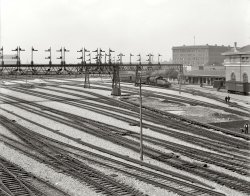
- Mourning McKinley: 1901
- ... to figure it out--I was born there in 1950. Dating to the Civil War era, the hospital moved in the 1950s to larger quarters in Northeast. The ... Posted by Dave - 02/03/2021 - 10:29am -
![Mourning McKinley: 1901 Washington, D.C. "View from Randall School of H Street S.W., between Half & First Streets, in 1901 showing coal yard and old homes near railroad station. Houses have McKinley memorials. Portrait of President William McKinley draped in black is visible on the house on the left. A flag is at half mast on the right." Along with at least two other McKinley portraits. 8x10 inch glass negative, D.C. Street Survey Collection. View full size.
Oddly lonelySuch a stark contrast exists between the pretty house with delicate embellishments casting lacy shadows -- the two older folk porch sitting on an early autumn afternoon; the younger woman dressed like an Old West frontier female standing by, arms crossed; the hatted child playing at the edge of the sidewalk -- and the rest of the landscape, which appears suspended in a dusty, lonely languor.
McKinley's destinyThe assassination of William McKinley made Theodore Roosevelt President at the age of 42. When TR became Vice President earlier that same year, his friend Charles G. Washburn remarked: "I would not like to be in McKinley's shoes. He has a man of destiny behind him."
Buffalo / DallasI was 7 when President Kennedy died. I never hear mention of Dallas without thinking of his assassination. I've always wondered, did people who were alive when McKinley died have similar associations with Buffalo, where he was assassinated?
TRElsewhere in the city, "that damned cowboy" Teddy Roosevelt has just become the new President.
All the houses with TepeesI had always assumed that the little turrets, or cones on the corners of houses were purely for appearance. I wonder whether they also played a structural purpose since more than two dozen of them are visible in the picture.
McKinley's DeathWhen he died President McKinley was widely and deeply mourned. The trappings of official and Victorian mourning with black crape and formal mourning attire were everywhere. But so also were touching demonstrations by simple people throughout the country where public assemblies and special services in churches were held. The route of his funeral train was lined by ordinary working class people standing shoulder to shoulder with the well off and powerful. People placed coins and flowers on the train tracks and kept the flattened remnants as mementos. At almost every stage of the journey local bands appeared playing the hymn "Nearer My God to Thee," a popular hymn and Mr. McKinley's favorite long before it became associated with the Titanic disaster. McKinley was a deeply religious man and according to popular legend (disputed) his last words were from the opening verse of the hymn.
Here is a link to some rare film footage of the official ceremonies and funeral procession. https://youtu.be/gTQrpsZ3tQA
LOCIs that the Library of Congress in the distance on the left?
Ballast = coalI believe we're looking at a coal dealer. Note that some of the bays are divided so the coal can be sorted as to lump size and possibly some choice Anthracite in there.
Seems to be a small cart-ramp extending over yet more bays below.
Displaying FlagsFlags are flown at half mast aboard ships. On land they are flown at half staff.
Jefferson BuildingThe partially visible large building in the upper left of the image is southeast corner of the Jefferson Building of the Library of Congress, which was completed four years before the image was taken.
Lehigh ValleyThe elevated rail arrangement and piles of ballast in the center-right of the photo remind me of all the comments and speculations last week with regard to Earth Movers: 1901.
Building IDI'm curious about the complex of large white (at least in this picture) buildings in the upper right. Can we identify that?
It's on the MapGoats of Venus has indeed got it right. [As does the photo caption, which calls it a coal yard - Dave] A look at a 1904 Sanborn Fire Insurance map shows this to be the Allegheny Coal Co. The map clearly shows the hard and soft coal trestles as well as the other structures on the site. Even more fascinating, it matches up perfectly with the houses in the image (facing H Street) and accurately shows their construction, with the pink color representing brick and yellow being frame. Even the 2-story frame porch on the house in the foreground is shown on the map as well as the split brick and frame construction of the first house around the corner on Half Street.
Building ID FoundAfter much sleuthing, including trying to get the right perspective using old DC maps, I can positively identify the large white building in the upper right as being the “old” Providence Hospital located at the time at 2nd & D Streets SE on Capitol Hill (see the image in the plaque below).
I’m a bit embarrassed it took me so long to figure it out--I was born there in 1950. Dating to the Civil War era, the hospital moved in the 1950s to larger quarters in Northeast. The buildings in the photo were razed and site became Providence Park, which still exists today. Incidentally, a number of previously published Shorpy photos were taken around the same time frame from the roof of the hospital, including several pointed back in the general direction of the Randall School—the reverse of where we’re looking from in the photo above.
The fall of a sparrowThe prominent group of structures at 2 o'clock is the old Providence Hospital complex. It's a park now.
(The Gallery, D.C., D.C. Street Survey, Railroads)](https://www.shorpy.com/files/images/SHORPY-40417a.thumbnail.jpg)
- Bustling Boonton: 1900
- ... those apocryphal cockroaches that would survive a nuclear war would be dining off them.
Still around, although no longer made in ... powering a bit of a hipster influx these days. The Civil War monument at right still stands; and the legacy of the Delaware, ... Posted by Dave - 10/25/2017 - 10:54am -
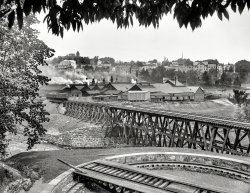
- A Dark Chapter, in Color
- ...
Great Work It's amazing how the fact that all Civil War photography was black and white makes the era seem less real. I have seen ... Posted by Fredric Falcon - 09/20/2011 - 1:22pm -
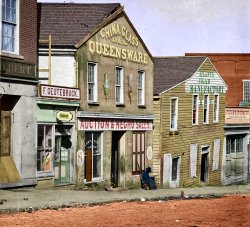
- Steelhenge: 1908
- ... or portions thereof. I wonder if some old locos of about Civil War era sacrificed the wheelsets as they met their demise.
Seems Like (Not ... Posted by Dave - 06/05/2016 - 6:01pm -
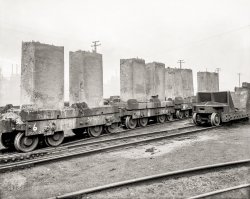
- The General: 1964
- ... train called the General #3 (yes, the General from the civil war), and that was it. I fell in love with trains. This photo was taken by me ... Posted by paulPaulsBest - 01/18/2010 - 3:03pm -
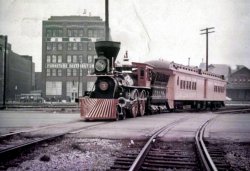
- General #3: 1964
- ... train called the General #3 (yes, the General from the civil war), and that was it. I fell in love with trains. This photo was taken by me ... Posted by paulPaulsBest - 01/15/2010 - 9:12am -
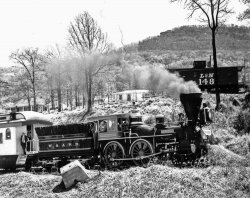
- Illinois Central: 1942
- ... that has been applied to every steam locomotive since the Civil War. With no moving parts, it takes steam from the boiler (the pipe connection ... Posted by Dave - 07/21/2014 - 12:40pm -
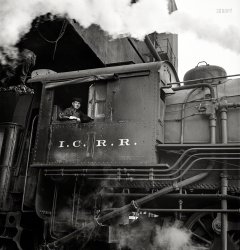
- Hoboken Public Bath: 1905
- ... from Catskill to Albany. Pressed into service during the Civil War, she became known as the Union Army's "greyhound" (not to be confused with ... Posted by Dave - 02/13/2017 - 10:44am -
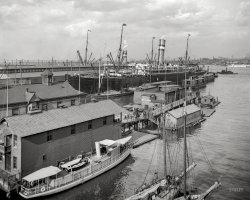
- Burned Out: 1942
- ... junk dealer." Photo by Marjory Collins for the Office of War Information. View full size.
Been on its legs all day That stove ... stuff was lost to WWII scrap drives - Revolutionary & Civil War cannons from innumerable city parks, statues, plaques, monuments, ... Posted by Dave - 03/10/2013 - 10:56pm -
